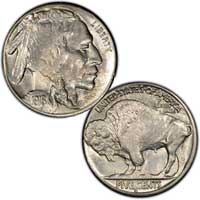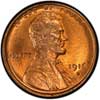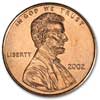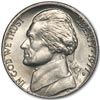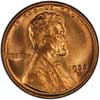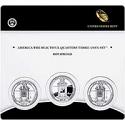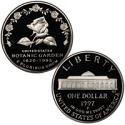Although fully struck mint state coins are difficult to locate, many circulated pieces are sharper in detail. This is simply the luck of the draw. An area of particular weakness is the tip of each feather. Some coins, even well struck pieces, display die erosion just inside the obverse and reverse borders. This appears as a thin ring of built up metal that gives the impression of a second border. While attractive to some collectors, it may be disturbing to others.
1916-S nickels typically have very nice luster. Well struck examples are likely to be frosty or satiny, while the softer ones may have very a bright and metallic surface.
Varieties:Two similar and quite major cud die breaks are known in which part of the obverse die has broken away. A lesser cud is known at the bison’s tail. Although commonly classified with error coins, this phenomenon is more correctly described as a variety. Whereas error coins are each unique, a cud will appear on every coin struck from a die possessing this defect until it is spotted and the die removed.
Mintage:
| Philadelphia | Denver | San Francisco |
| 63,497,466 | 13,333,000 | 11,860,000 |

